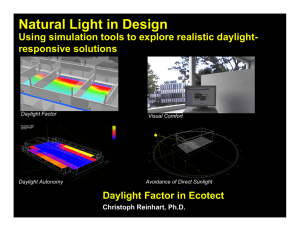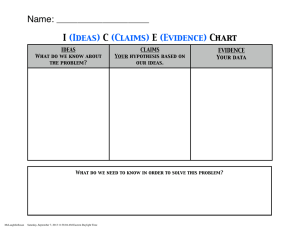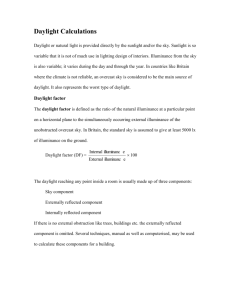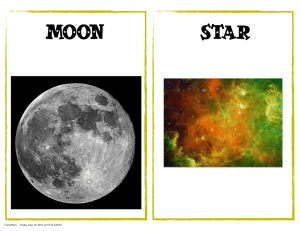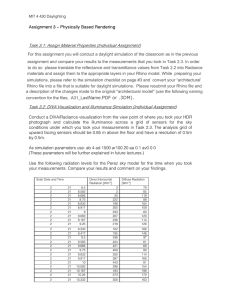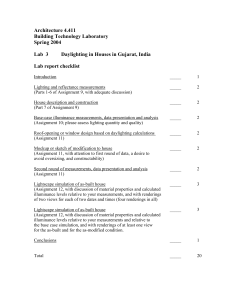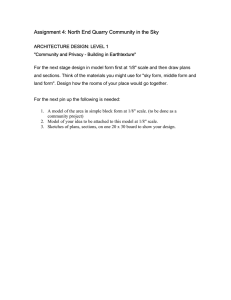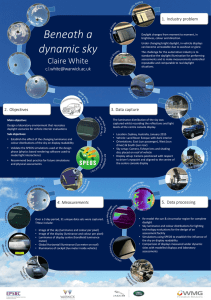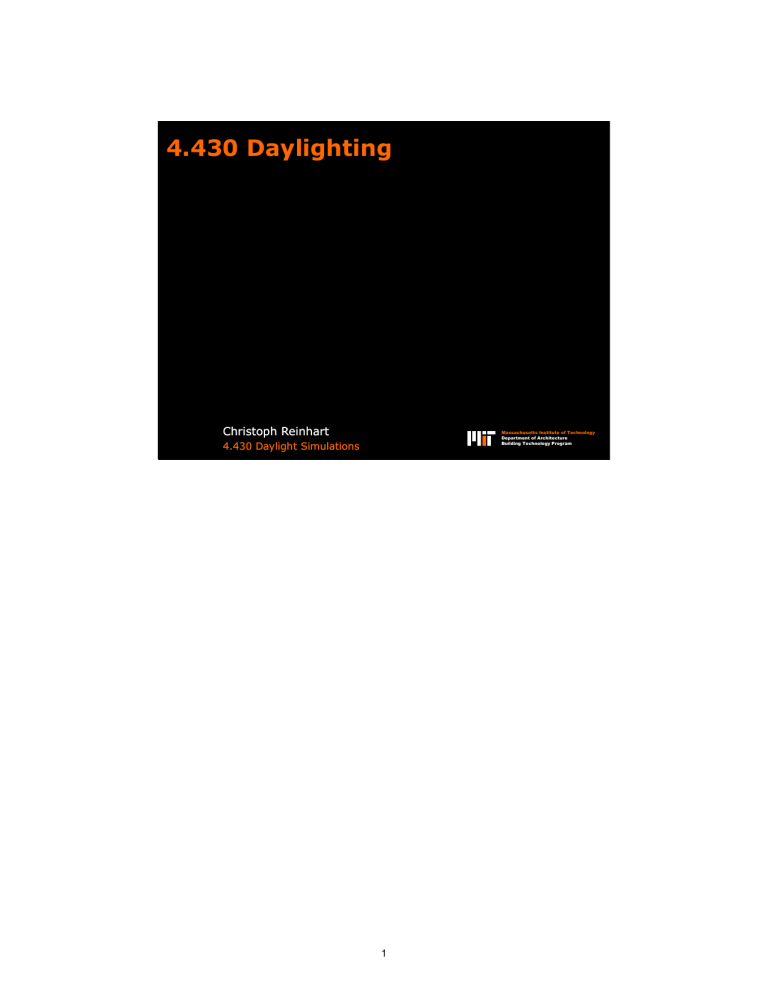
4.430 Daylighting
Christoph Reinhart
Massachusetts Institute of Technology
Department of Architecture
Building Technology Program
4.430 Daylight Simulations
1
MISC
Google DIVA forum , onebuilding.org, radianceonline.org
Most of the concepts discussed in this lecture are covered in
Reinhart C F, “Simulation‐based Daylight Performance Predictions“,
in Building Performance Simulation for Design and Operation,
Editors J Hensen and R Lamberts, Taylor & Francis, 2011
Daylight Simulations
2
Daylight Simulation
A computer-based calculation of the amount of daylight available
inside or outside of a building under one or several sky conditions.
Simulation outputs may be discrete numbers (illuminances and
luminances) under selected sensor points within a scene or
visualizations of a scene.
Visualization
Daylight Factor Distribution
Who should ‘do’
daylight simulations?
3
Architects!
Better interfaces. Faster computers.
To interactively improve your design at the schematic design stage.
To be able to engage in a dialogue with the HVAC engineer.
Competitive edge: high demand for simulationists
Opportunity to work on more interesting projects.
Questions to ask when choosing a
daylight simulation program
What do you want to calculate?
Has the software been validated?
How easy is it to learn?
4
Elements needed for a DL Simulation
Sky Model
Building Model
Simulation Algorithm
Area of Interest (analysis grid)
Daylight Factor Calculation Methods
Average Daylight Factor (Lynes formula – see rules of thumb)
Original Split Flux Method (Daylight Factor Protractors)
Split Flux Method in Ecotect
Raytracing/Radiosity
5
Split Flux Method (Daylight Facotr)
UK Building Research Establishment (BRE)
SC == direct component
ERC == externally reflected component
IRC == internally reflected component
DF= SC + ERC + IRC
Design Sky Values
Design Sky values represent a horizontal illuminance level that is exceeded 85% of the time
between the hours of 9am and 5pm throughout the working year. Thus they also represent
a worst-case scenario that you can design to and be sure your building will meet the
desired light levels at least 85% of the time.
Diagrams of raytracing and the split flux method removed due to copyright restrictions.
Limitation in Ecotect: Climate files are not used by lighting simulation.
6
Protractor Method I
SC
ERC
Square One web site
© Andrew Marsh. All rights reserved. This content is excluded from our Creative
Commons license. For more information, see http://ocw.mit.edu/fairuse.
Daylight Factor Protractors
Protractor Method II
© Andrew Marsh. All rights reserved. This content is excluded from our Creative
Commons license. For more information, see http://ocw.mit.edu/fairuse.
Square One web site
7
Protractor Method III
© Andrew Marsh. All rights reserved. This content is excluded from our Creative
Commons license. For more information, see http://ocw.mit.edu/fairuse.
Protractor Method IV
DF = SC + ERC + IRC
= 1.52% + 0.0456% + 1.7586%
= 3.324 %
In Boston:
Design sky
= 7566 Lux (Tregenza formula)
Light Level
= 7566 Lux x 3.324%
= 251 Lux
8
Split Flux Method in Ecotect
A geometric version of the Split Flux Method (BRE)
Raytracing: each ray represents an approximately equal solid
angle of sky
Diagrams of raytracing and the split flux method removed due to copyright restrictions.
Split Flux Method in Ecotect
A geometric version of the Split Flux Method (BRE)
Raytracing: each ray represents an approximately equal solid
angle of sky
Diagrams of raytracing and the split flux method removed due to copyright restrictions.
9
Split Flux Method in Ecotect
Diagrams of raytracing and the split flux method removed due to copyright restrictions.
A Sky Component (SC) is modified by:
relative sky illuminance of that particular sky patch
relative angle of sky patch makes with a horizontal surface
visible transmittance of each glazing material through which it travels
Note: Difficulty of not having access to source code.
Split Flux Method in Ecotect
Diagrams of raytracing and the split flux method removed due to copyright restrictions.
An Externally Reflected Component (ERC) is modified by:
luminance of the sky it would have hit
reflectance of the material assigned to the external object
relative surface angle and glazing transmittances
10
Split Flux Method in Ecotect
Diagrams of raytracing and the split flux method removed due to copyright restrictions.
An Internally Reflected Component (IRC) is modified by:
store internal surface reflectance of the object
altitude angle of the ray is used to determine which parts of the IRC
formula the ray contributes to.
How accurate is Ecotect? Comparison of a
Best Practice Model using Ecotect-Split-Flux
vs. Radiance
New Text
Courtesy of Diego Ibarra and Christoph Reinhart. Used with permission.
Best Practice Model Ecotect
= 0.55%
Mean Daylight Factor =
Best Practice Model Radiance
= 2.59%
Mean Daylight Factor =
Percentage of floor area >2% == 0%
= 42%
Percentage of floor area >2% =
-- dramatic difference between both engines due to wall thickness
Paper: Ibarra D, Reinhart C F, "Daylight factor simulations - 'How close do simulation beginners 'really' get?“, Proceedings
Building Simulation 2009, www.ibpsa.org/proceedings/BS2009/BS09_0196_203.pdf
11
Radiance
Survey on the Use of Daylight Simulations
185 participants from 27 countries (40% Canada & US)
validation seems less of an issue
out of 40 tools mentioned, >50% of votes for RADIANCE based tools
Paper: CF Reinhart and A Fitz, "Findings from a survey on the current use of daylight simulations during building design",
Energy and Buildings 38:7 pp. 824-835, 2006.
12
Radiance Validation Studies
Energy & Buildings
Reinhart, Walkenhorst 2001
Light. Res. & Technology
Mardaljevic, 1995
102_92_13h00
105
Clear Glazing
Prediction
100
Measurement
103
102
10
20
20
0
0
-20
-20
0
2
4
6
8
10
Distance from window (m)
0
2
4
6
8
10
Distance from window (m)
Image by MIT OpenCourseWare.
Daylight Autonomy [%]
Illumination (lux)
RE (%)
60
121_92_14h15
measured
1000
Clear Glazing
104
Energy & Buildings
Reinhart, Andersen 2006
50
simulated
40
climate Data: i
30
20
10
0
0
200
400
600
800
1000
illuminance threshold [lux]
Conclusion: Radiance combined with daylight coefficients and Perez
sky model can efficiently and reliably model annual illuminance time
series with a mean relative error of 20%.
Some Facts on Radiance
Physically based backward raytracer –- no fudge factors.
A wide variety of material properties and sky models.
Longish learning curve. (“Magic” lies in simulation parameters.)
13
Backward vs. Forward Raytracing
forward raytracer
backward raytracer (Radiance)
Demo: Visualization
14
Source: R Compagnon
Parameter Study Radiance: ab 0 to ab 8
15
Radiance Scene Complexity I
ambient
bounces
5
ambient
division
1000
ambient
sampling
20
ambient
accuracy
0.1
ambient
resolution
300
direct
threshold
0
direct
sampling
0
recommended Radiance simulation parameters
Radiance Simulation Parameters I
ambient
bounces
5
ambient
division
1000
ambient
sampling
20
simulation resolution =
Example:
ambient
accuracy
0.1
ambient
resolution
300
direct
threshold
0
direct
sampling
0
max scene dimensions x ambient accuracy
ambient resolution
100m x 0.1
300
16
~ 3cm (window mullion)
Radiance Scene Complexity II
higher raytraing parameters for blinds
ambient
bounces
7
ambient
division
1500
ambient
sampling
100
ambient
accuracy
0.1
ambient
resolution
300
raytracing detail
direct
threshold
0
direct
sampling
0
recommended Radiance simulation parameters
USDA Consolidation Laboratories
Ames, Iowa - AEC
Courtesy of Zack Rogers, PE, President, Daylighting Innovations. LLC. Used with permission.
Balance of daylight distribution in adjacent office and laboratory spaces.
Rules of Thumb do not apply any more.
17
simulation: AEC
Limitations of Radiance
Radiance will not necessarily „find“ the sun.
Mention Photon Mapping.
Daylighting Test Cases
18
Daylight Simulation Test Cases
Facade section drawings of the daylighting test
cases removed due to copyright restrictions.
Photograph of NRC Daylighting Laboratory
removed due to copyright restrictions.
Paper: Reinhart C F, Breton PF, "Experimental Validation of 3ds Max® Design 2009 and Daysim 3.0", LEUKIOS 6:1 2009.
(www.autodesk.com/us/3dsmaxdesign/B3241.MentalRayValidation_v3.pdf)
3ds Max Design 2009
Based on ExposureTM technology.
Screenshot of rendered interior using Autodesk 3ds Max
Design 2009 removed due to copyright restrictions.
ExposureTM includes a ‘shader’ of the Perez
Sky Model (same model as Daysim).
For the global illumination calculation Exposure
uses the mental ray raytracer which supports
forward (photon mapping) and backward
raytracing (final gathering).
Same as in Radiance final gather tracing in
mental ray is performed only on discrete points (sensors).
Light sensors in 3ds Max Design are specified using the Light Meter object.
Tutorial: http://images.autodesk.com/adsk/files/3dsmax_started.pdf
19
Validation Work Flow
SketchUp Model (geometry)
Outside Irradiances
Illuminances
Material Properties
Simulation Program:
- 3ds Max Design 2009
-Daysim3.0
-…
Simulated Illuminances
Outside Façade Illuminances
Graph of illuminance (outdoor sensor on a sunny day)
removed due to copyright restrictions.
Graph of illuminance (outdoor sensor on a partly cloudy day)
removed due to copyright restrictions.
Clear Sky
Partly Cloudy Sky
Nearly identical simulation results for outside sensors.
Differences mainly from how ground reflectances are being treated.
20
Test Case 1 – No Shading
Image of SketchUp model of the East Room for the
test cases removed due to copyright restrictions.
Graph of illuminance (base case) removed
due to copyright restrictions.
Very close agreement over a large illuminance range.
Slight offset probably due to geometry modeling errors and time lacks.
Test Case 2 – Lightshelf
Graphs of illuminance (lightshelf) removed due to copyright restrictions.
Very close agreement from 50lux to 8000lux (covers total range typically encountered in buildings.
21
Test Case 5 – Internal Venetian Blinds –
Sunny Day
Image of SketchUp model of Venetian blinds
removed due to copyright restrictions.
Graphs of illuminance (external blinds on a sunny day)
removed due to copyright restrictions.
Systematic error under sunny sky conditions for both programs.
Modeling challenges: Setting the slat angles evenly; measuring optical properties of blind slats (specular
component); light spilling through cord holes.
Main Study Findings
3ds Max Design and Radiance/Daysim can be used to support
daylighting related design decisions in scenes of comparable complexity as
the five daylighting test cases.
This finding constitutes a certain paradigm shift as there are suddenly
more than one lighting simulation engine that has been extensively
validated based on physical measurements.
It is expected that other programs will soon also undergo comparable
simulation procedures.
22
MIT OpenCourseWare
http://ocw.mit.edu
4.430 Daylighting
Spring 2012
For information about citing these materials or our Terms of Use, visit: http://ocw.mit.edu/terms.

